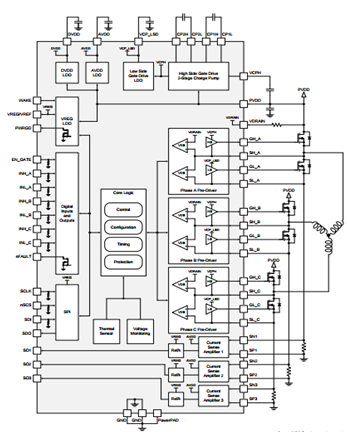SSZTAR8 october 2016 DRV8305 , DRV8305-Q1
In the previous installment we had just discussed EV auxiliary motor systems. Most of these are low voltage and low to medium current three-phase brushless DC motors which can – with the right expertise – be controlled without mechanical rotor magnetic position sensors (sensorless). These three-phase motors are energized by a three phase inverter, which switches DC voltage through three parallel legs to ground. Each phase of the motor is connected to the midpoint of a leg, allowing for current flow through a phase between Vdc and ground.
The components used to energize each phase of the three phase motors in the inverter system are MOSFETS. As seen in Figure 1 below, six MOSFETs are arranged in a totem pole fashion, creating three half bridges to switch each coil to the DC voltage and ground.
 Figure 1 Integrated Three Phase Gate
Driver (DRV8305) with External FETs
Figure 1 Integrated Three Phase Gate
Driver (DRV8305) with External FETsUnlike low voltage MOSFETs, High Voltage/Current FETs cannot be driven directly from the microcontroller (MCU). Due to the high threshold voltage and high amount of capacitance that is parasitic to the FET (typically >100pF.), a driver IC must be used to drive the gate of the FETs (typically termed gate driver). Modern gate drivers in (1kW three phase motor systems) integrate many features that are important to the overall system’s reliability and performance. These key features are based on protection, configurability, build of material / board size reduction and motor control performance. The DRV8305-Q1 is best in class in each one of these features.
Since MOSFETs are the key components energizing the three phases, they are the most critical to be protected. The DRV8305-Q1 offers multiple layers of protection for the overall system by having integrated VDS and VGS monitoring of the external FETs, on chip thermal measurement, three integrated current shunt amps to monitor current flow through the FETs, MCU watchdog, power supply monitoring for under and over voltage and shoot through protection with smart gate drive. Out of each level of performance, smart gate drive is where DRV8305-Q1 differentiates itself from other gate drivers. It offers three levels of MOSFET cross conduction or shoot through protection by allowing the user to set a minimum dead-time (time between high side and low side switches being on) and by implementing a strong gate pull down to prevent dv/dt conduction. For further details on smart gate drive, read our app note “Understanding IDRIVE and TDRIVE in TI motor gate drivers.”
Along with protection the DRV8305-Q1 integrates many high performance features that will eliminate many devices and material that is seen on a typical BOM. The first of those is configurability and diagnosis communication through a serial peripheral interface (SPI). Each one of the failure mechanisms mentioned above will be reported on the SPI port when there is a failure. The SPI port can also be used to program or configure many features. A key feature is the gate drive current, eliminating the need for resistors on the gates of the MOSFETs. It can program the current as low as 10mA and as high as 1.25A, allowing users to tune for optimal gate drive and EMI performance. Other key features that are programmable are the gain, bias and blanking time of the current sense amps.
Lastly, the DRV8305-Q1 is great in improving motor performance by aiding in each control algorithm and method from simple trapezoidal to sinusoidal FOC. This is made possible by the single, three or 6 channel pulse width modulation (PWM) options and high performance current shunt amps. To aid in FOC, each current shunt amp must be able to make a fast and accurate measurement of the current in each phase leg. The DRV8305-Q1 offers current sense amp calibration via the SPI port to minimize inaccuracy related to offset voltage.
Learn more:
- Learn more about EV devices
- Start developing your next motor with Delfino F2837x MCUs
- Download the motor control whitepaper for your EV device
- Read our whitepaper: Intelligent battery management and charging for electric vehicles
- Read more about DC/DC battery conversions
- Read our blog series on motors in electric vehicles